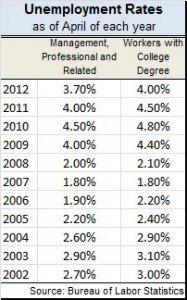Note: This is an excerpt from a longer newsletter article that Bob Marshall sends every month after the U.S. Labor Department issues its monthly employment report.
The unemployment rate is published by the Bureau of Labor Statistics, a division of the U.S. Department of Labor. The rate is found by dividing the number of unemployed by the total civilian labor force. On May 3, the BLS published the most recent unemployment rate for April which was 7.5%. (Actually it is 7.510%, down .064% from 7.574%, in March 2013.)
The unemployment rate was determined by dividing the number of unemployed — 11,659,000, down from the month before by 83,000. (Since April, 2012 this number has decreased by 859,000.) — by the total civilian labor force of 155,238,000 (up by 210,000 from March, 2013). Since April 2012, our total civilian labor force has increased by 787,000 people.
On the surface, these new unemployment rates are scary, but let’s look a little deeper and consider some other numbers.
The unemployment rate includes all types of workers — construction workers, government workers, etc. We recruiters, on the other hand, mainly place management, professional, and related types of workers. That unemployment rate in April dropped to 3.5% down from last month’s 3.6%). You can also look at it another way. We usually place people who have college degrees. That unemployment rate in April increased to 3.9% (up from last month’s 3.8%).
Now stay with me a little longer; this gets better.
The ‘New Normal’ Unemployment
It’s important to understand (and none of the pundits mention this) that the unemployment rate, for many reasons, will never be 0%, no matter how good the economy is. Without boring you any more than I have already, let me add here that Milton Friedman (the renowned Nobel Prize-winning economist), is famous for the theory of the “natural rate of unemployment” (or the term he preferred, NAIRU, which is the acronym for Non-Accelerating Inflation Rate of Unemployment). Basically, this theory states that full employment presupposes an ‘unavoidable and acceptable’ unemployment rate somewhere between 4-6%. Economists often settle on 5%, although the “New Normal Unemployment Rate” has been suggested to fall at 6.7%.
Nevertheless (if you will allow me to apply a ‘macro’ concept to a ‘micro’ issue), if this rate is applied to our main category of Management, Professional and Related (one of the top-level categories in the monthly employment report from the BLS) types of potential recruits, and/or our other main category of college-degreed potential recruits, we find no unemployment! None! Zilch!
Now back to the issue at hand, namely the recruiting, and placing, of professionals and those with college degrees.
If you take a look at the past few years of unemployment rates in the month of April,  what you find is summarized in the accompanying chart.
what you find is summarized in the accompanying chart.
So, while April’s 2013 rates for these two categories, 3.5% and 3.9%, respectively, are trending positively, when looking at the big picture, it’s not anything to be very happy about either — especially when we see how well we had it during the 2002-2008 time frame. But then, these unemployment numbers usually include a good number of job hoppers, job shoppers and rejects.
We, on the other hand, are engaged by our client companies to find those candidates who are happy, well-appreciated, making good money and currently working and we entice them to move for even better opportunities — especially where new technologies are expanding. This will never change. And that is why, no matter the unemployment rate, we still need to market to find the best job orders and we still need to recruit to find the best candidates.